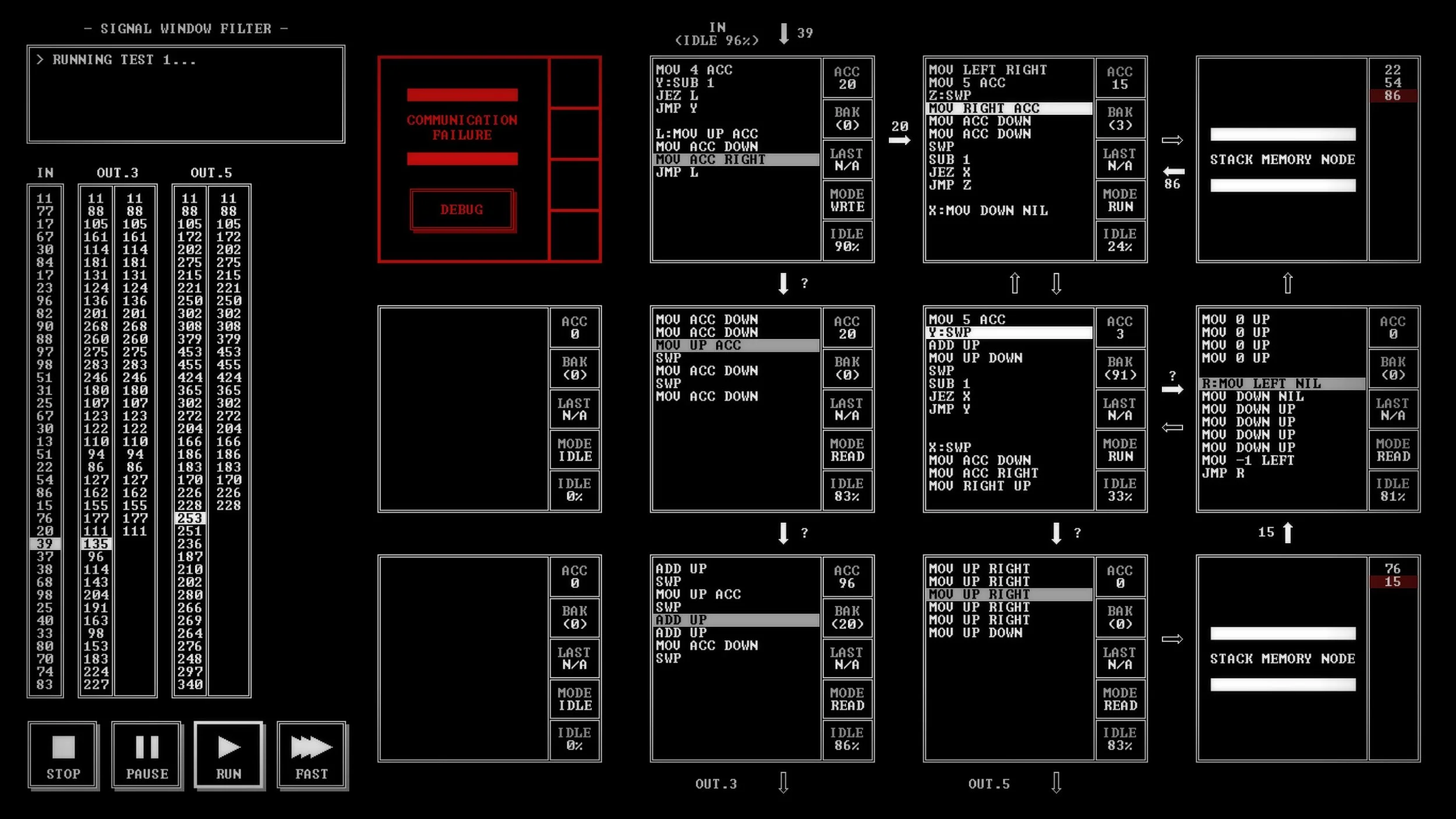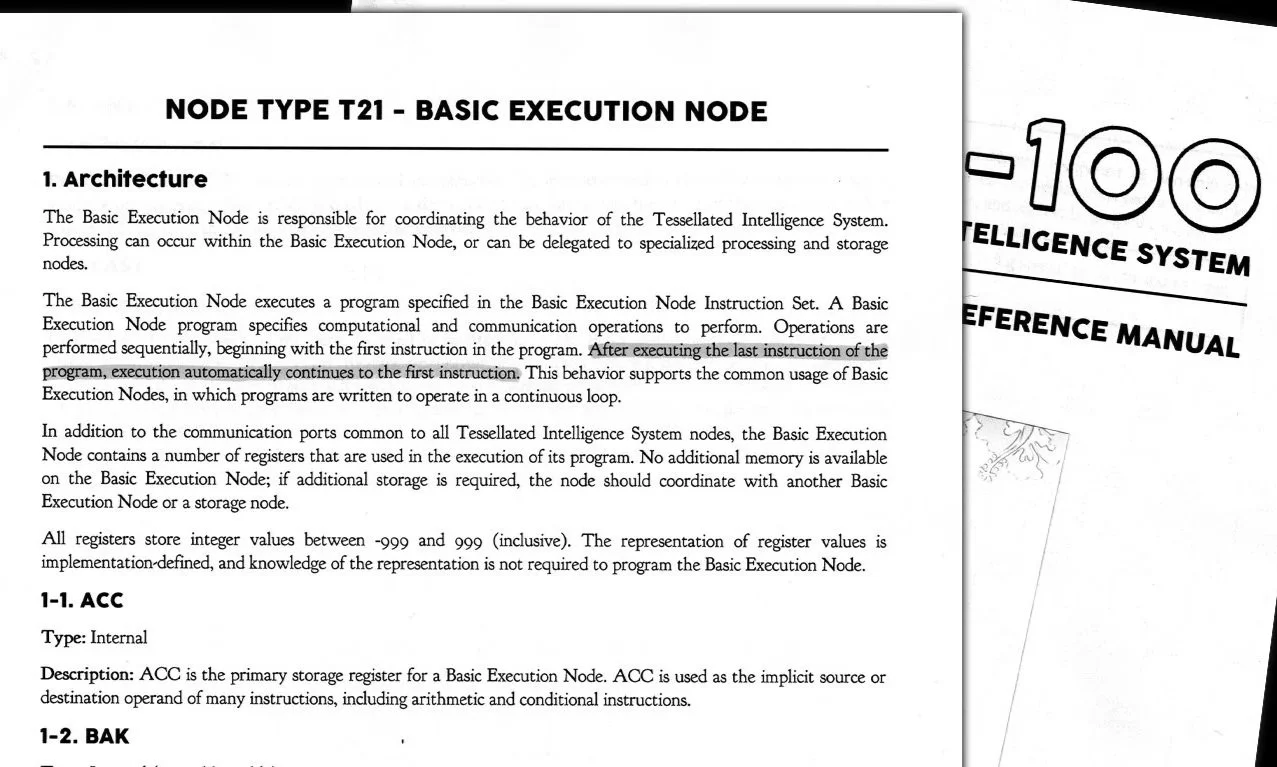TIS-100 - Inaccessible, brilliant
Eye Catching Gameplay!!!
TIS-100 by Zachtronics is one of the most challenging and intrinsically rewarding games I have played. It has a cool, vibey feel and is packed with brain teasers that will keep you staring at your computer screen for hours. It will have you pulling out paper, sketching flow charts, and working through simple programming puzzles. It’s a programming and logic puzzle game with a light story that never really takes center stage; instead, the game is all about challenging you as you focus for hours on end. The puzzles are very similar to exercises you might find in a beginner coding course, which means this game appeals to a small niche of people. I'm glad it exists, but I’m also surprised someone took the time to develop it at all!
As someone who enjoys coding, I found the game extremely addictive. The puzzles were challenging and reminded me why I wanted to pursue computer science back when I went to university (before realizing I couldn't pass the math courses). I always felt a great sense of satisfaction whenever I finally found the solution and saw the puzzle completion screen. It made me feel like I was a genius!
The puzzles themselves are a 10 / 10 affair. However, the story side of things is where the game is weakest. Accessibility is also one of this game's downfalls. Ironically, programming in TIS-100 is more difficult than any real-life example most people will work on. The game is also uninterested in helping you solve the puzzles. While the difficulty increases gradually and introduces new concepts over time, I would not say the game ever teaches you anything. It expects you to bring a lot of programming knowledge to the table, and it assumes you have done similar puzzles before. It wants you to see this as an interesting twist on problems that are very familiar to anyone who has dabbled in basic computer science concepts.
All this makes TIS-100 unapproachable, which is unfortunate for such a brilliant game.
Now… be honest, did you notice this is a different photo from the previous one?
Opening Vibe
When you launch the game, your screen turns into a 1970s terminal with all the humming and noise of that bygone era. You will feel immediately out of your element. It invokes an overwhelming feeling, familiar to anyone who rarely opens the CMD terminal on their Mac or PC, or has tried to use Linux for the first time. A recognition that, despite the simplicity of this text-only interface, there is a great deal of power and complexity lying below the surface. Far more than the hand-holding visual interfaces we are mostly familiar with.
At this point, the game does something truly novel: it gives you a user manual! This, for me, is the game's true brilliance. There is an attempt to fully emulate the experience of using these ancient computers, with paper manuals and hand-scribbled notes. This simple tool brought a level of immersion that I was not expecting. And elevated the game in that moment.
You will quickly scroll through the manual and be overwhelmed again. There are some descriptions of how the TIS-100 computer system works and the simple commands at your disposal. Text highlighted by the protagonist's uncle Randy when he first found this computer hints towards solutions for future puzzles. The vibe at the start of the game is perfection. Which is critical. It solves a key issue this game has: how do you tell a story through computer coding, without ever breaking the illusion that you are using a 50-year-old computer? Through this manual and some very short snippets of dialogue hidden throughout the game, a mystery starts to open up. Why does this computer exist? What secret lurks behind that black and white text? What does solving these puzzles achieve?
You will, of course, discover some of these mysteries, but ultimately, I found the story to be rather weak. It never moved passed being set dressing for the puzzles. A bit of salt to make the gameplay more palpable. The game ultimately fails to live up to the opening vibe. Any hints to what may be lurking below the surface of the interface are red herrings. I would have liked to see more depth, perhaps finding more ARG elements sprinkled in; things like finding more PDFs or any sort of secrets.
While there are a few easter eggs, there is no real secret lurking beneath the TIS-100. Instead, there is just a feeling and vibe. While I enjoyed this experience, it feels to me like a missed opportunity. It would elevate this game from merely a coding puzzle game to indie-gaming greatness. The kind of creativity and novel storytelling that only pops up occasionally.
You know you have hit gold when your game’s steam page include screen shots of a PDF.
Gameplay
As I have mentioned, the puzzles take the form of simple programming exercises. Mostly, number sorting. The screen consists of a grid of boxes. One of these boxes is the input, and a number will appear in this box. You have a handful of commands to move and manipulate this number across the grid to an output box. Your goal is to move the numbers towards the output box in the correct order.
Simple enough! Using the commands you have, you can move numbers around, create loops, add or subtract, and do very simple true or false tests. Each box has a set number of lines of code, and you can only work with 1 number per box.
Already, I've probably lost most of you! But the game is quite simple. There is no deep knowledge necessary. This game could have been simplified to be more visual-based than text-based and have lost none of its complexity. Something along the lines of Baba is you, or other logic puzzle games.
The difficulty of the puzzles will vary from person to person. If you bring a lot of experience to this game, you may find it very easy. If you are a complete novice, you will have to do some studying to complete the puzzles. Personally, I found most of the puzzles solvable in about 30 minutes to an hour. Most of that time was spent debugging my code, trying to correctly write the solution I had already discovered 20 minutes previously. Which, I might point out, is a weakness of asking players to write these simple programs. Finding errors in your code can be frustrating and time-consuming, and I am not certain makes for a good game. Anyone who does this kind of work for a living can tell you, debugging is one of the worst parts of the job.
I found myself frustrated after spending time trying to understand why my code wouldn't run correctly, only to discover a typo on my part. I wonder if many would simply not tolerate this experience. I also wonder if there was a missed opportunity to bring quality of life elements or debugging tools. Perhaps, even a simpler and forgiving programming language could have gone a long way towards making this less like work and more like a game.
This is a puzzle completion screen. I think I’m proud of the score I got…. I’m not actually sure…
While most puzzles I could solve rather quickly, others really took some time to ponder and think. I was sometimes driven mad, knowing I could solve the puzzle if I only had 1 more line of code in a box. It was an enjoyable experience and forced me to think in a very specific way, which only programming does.
Which, at this point, you might be asking: why is he both being so negative, but keeps saying he loved the game? That is the joy of programming! Problem-solving contrasted against the art of debugging. Moving your solution from thoughts to reality. When you write computer programs, you feel like a digital wizard engaged in a numerical alchemy. You are giving the computer a mind of its own! Creating processes and thought where initially there is only inert metal.
This is where the fun of this game comes from. It creates a space for you to solve problems using this computer wizardry and rewards you with a score based on how good your solution is. For those with the prerequisite skill, this game is addictive and fun. It uses a part of your brain that is often only used for work or hobbies, and applies it to a game.
I find this so enjoyable, and this game so well executed, that I wish it could be shared with a wider audience. I feel, had the developers decided to, it could have been given more of an on-ramp, so more people could enjoy this game.
There are a lot of puzzles.
Accessibility Problems
For example, the game has no true hint system. The PDF teaches you the commands you need and gives some examples of how the code works, but this is a technical document. It's difficult to read and cryptic. The PDF manual is a puzzle in itself, and is necessary because you cannot even begin to solve the puzzles without it. However, I think it could go a bit further to actually teach some concepts. If you have never taken a computer science course, the PDF may be completely useless. It assumes you know what a loop is. Right now, some of you may be reading that word loop and be completely ignorant of its importance to programming. Without a thorough understanding of this basic concept of programming, this game is unbeatable.
With true or false statements of the game, there is an assumption that everyone will understand how to employ these. While these concepts are all very foundational to programming, to people who have never touched these concepts, this is quite a leap in thinking. Computer logic is not the default way people think. I know most people are capable of completing this game, but they need an on-ramp and explanation of these foundational concepts in programming.
If the game were to be more widely accessible, I believe there would need to be an attempt to introduce these concepts to the player. I don't knock the developers for wanting to focus on the puzzles and not teaching computer science, but it is still a missed opportunity and deeply affects how I might recommend this game. I full heartedly recommend this game to the minority of people who already have some knowledge of these concepts. But I would not recommend this game to anyone who has never touched these ideas before.
Did I already include this screen shot? I already told this joke, at the very least…
Final Thoughts
TIS-100 is a fun puzzle game. It is a programming sandbox that gives you freedom to find your own solutions to the problems it presents. It has the perfect vibe, which elevates this above being rote logic puzzles. It has just enough ARG fun to make you feel like you're not just doing someone's computer science homework. I might even suggest coding 101 classes assign this game to their students, as a fun and simple way to learn some very core concepts in programming.
As much as I loved it, TIS-100 falls short of its potential. The ideas are all there, and at times they sync up perfectly to create a novel experience. But it feels like the developers either did not recognize potential or simply did not want to pursue it. The story is shallow, hinting towards something deeper, but it does not deliver. The game is unapproachable by a majority of people; perhaps the developers felt it was necessary to challenge people in the know. In both cases, I do not fault the developers for wanting to focus on the core of making a great puzzle-solving game. But I do lament the untapped potential.
I would love to be able to share this game with more people. The puzzles are a delight. I think people would get a kick out of trying this. But there isn't anything to propel the masses to push forward, other than enjoying the puzzles for what they are. They teased something deeper and more complex, but never fully lived up to it. If you work for hours on a puzzle, hoping for a payoff other than a screen saying congratulations, you will be sorely disappointed.
I would recommend you play this game if you feel you have the necessary knowledge! You may enjoy the puzzles for the brain teasers they are. Worst case, you quit before the end. But, if you're looking for more in terms of story or onboarding to programming, this is not the game for you.






